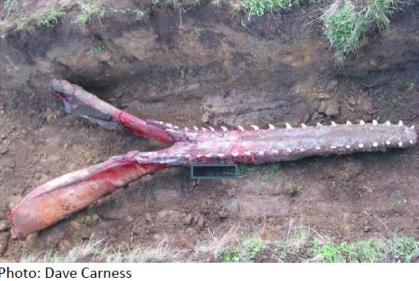TAXONOMY
Kingdom: Animalia
Phylum: Chordata
Class: Mammalia
Order: Cetartiodactyla
Suborder: Odontoceti (toothed whales)
Family: Physeteridae
Genus/species: Physeter macrocephalus
GENERAL CHARACTERISTICS: Have large square heads, comprising almost a third of the total body length with the largest and heaviest brain of any living animal. The head of a Sperm whales contains the spermaceti organ used in echo location. It is filled with a waxy liquid called spermaceti oil. Their single blowhole is located on the left of the head rather than on the top and they have a low, bushy spout, which is projected forward and slightly to the left. Their skin is wrinkled to increase surface area for heat loss, giving them a shriveled look. Color is dark brown to bluish-black and there usually is a large hump (no fin) on the back. There are 18-28 functional teeth on each side of the lower jaws, but the upper teeth are few, weak and nonfunctional. The lower teeth fit into sockets in the upper jaw.
Male length to 17 m (60 ft) in length, making it the largest toothed whale. Weight up to 54,431 kg (60 tons).
Female length to 12 m (37 ft), Weight to 24,494 kg (27 tons).
Photos below: Sperm whale, Initial Assessment, 2015, Pacifica See Pacifica Sperm Whale 2015 californiadiver.com/second-dead-whale-washes-ashore-in-pa…
 Photo Credit Denise Greig
Photo Credit Denise Greig Photo Credit: Duncan Sinfield, Youtube screenshot
Photo Credit: Duncan Sinfield, Youtube screenshot
DISTRIBUTION/HABITAT: Found in all of the oceans of the world except the high Arctic. Primarily an inhabitant of the open ocean in offshore areas, the Sperm whale may also occasionally be seen closer to land, providing that the water is deeper than 200 m (650 ft). In California, sperm whales can be seen in waters off the continental slope from November to April.
Photo Credit Denise Greig
DIET: Powerful sound waves are emitted from the head which can stun and perhaps kill squid, octopuses and fish including sharks and rays. They eat about 907 kg (2,200 lbs/1 ton) per day.
Note: Surprisingly teeth aren’t used mainly for eating. Male Sperm whales appear to use their teeth mostly for fighting other males. The whale sucks prey into its mouth and gullet which is large enough to swallow a man whole. Ref. Te Papa, New Zealand museum and The Encyclopedia of Life.
Photo Credit Denise Greig
REPRODUCTION: Mating occurs in spring and summer.After a gestation period of about 16 months, a single calf weighing up to 500 kg (1100 lbs.) is born between July and November. The calf is suckled for up to two years.
Females protect their young by adopting a defensive ‘marguerite formation’ in which the calves are surrounded by a circle of females, facing tail outwards.
Adult males lead a solitary life except for the breeding season. Female and young male sperm whales are social and sometimes are seen in pods, or groups, of up to 50 whales.
PREDATORS: Killer whales
CONSERVATION: IUCN Red List Vulnerable VU Large-scale hunting began in 1712 in the North Atlantic, based at Nantucket in America. These whales were not widely hunted for its meat, but for ambergris and spermaceti oil. Ambergris collects around the indigestible beaks of squid in the stomach of the whale, and was highly prized for use as a fixative in the perfume industry; spermaceti was used in the production of cosmetics and candles. Recent estimates suggest a global population of 300,000 animals, down from about 1,100,000 before whaling.
Although the International Whaling Commission brought an international moratorium on whaling into force in the 1980s Japan continues to kill whales and dolphins.
Threats: Japan continues to hunt Sperm whales every year at Lamalera, Indonesia using hand harpoons. Other threats include entanglement in fishing gear and collisions with boats.
REMARKS:
P. macrocephalus dives can last two hours and can be as deep as 3000m (9800 ft) making it the deepest diving mammal.
A white Sperm whale was featured in Herman Melville’s classic novel, Moby Dick.
SPECIAL NOTE: On April 15, 2015 biologists and researchers from the Marine Mammal Center and the California Academy of Sciences performed a necropsy on a beached sperm whale found below Mori Point in Pacifica. Because of its size the mandible is now on the Academy roof buried underneath some soil, which will allow the tissue remaining on the bone to decompose Exposure to the sun after removal from the dirt will naturally whiten the specimen which will become part of the Academy’s research collection.
Reference: Laura Wilkinson, California Academy of Sciences.

The photo below is a mandible from beached Sperm whale jaw several years ago. It was buried then excavated for further processing and study by the California Academy of Sciences.

References
Te Papa, the New Zealand museum Whale to the exhibit at the California Academy of Sciences 2015
Laura Wilkinson, California Academy of Sciences.
ARKive www.arkive.org/sperm-whale/physeter-macrocephalus/
National Geographic www.flickr.com/photos/cas_docents/18639770676/in/album-72…
Marine Mammal Center www.marinemammalcenter.org/education/marine-mammal-inform..
Monterey Bay Aquarium www.montereybayaquarium.org/animal-guide/marine-mammals/s…
Encyclopedia of Life eol.org/pages/328547/details
Ron’s flickr https://www.flickr.com/photos/cas_docents/18639770676/in/album-72157652727235908/
Ron’s WordPress Shortlink wp.me/p1DZ4b-1wI







